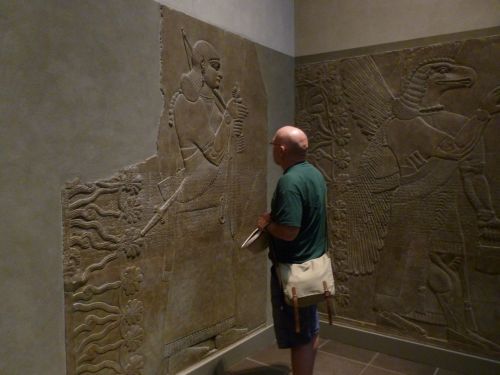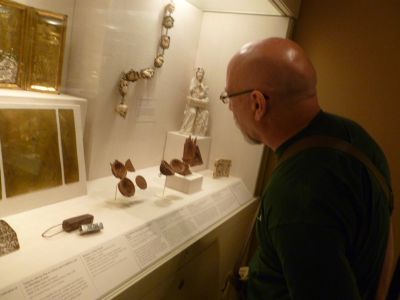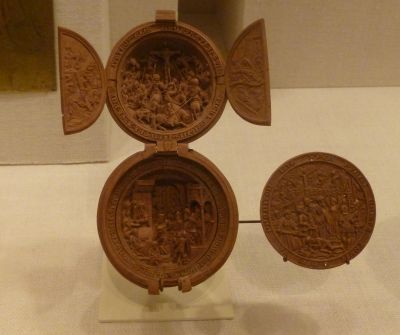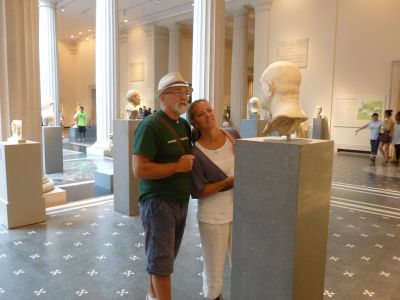|
|
08/16/2011 |
 During Chris Pye's visit to New York, Chris, Carrie his wife, and myself spent a few hours wandering around Manhattan and also wandering around the Metropolitan Museum. The Met is huge, and cannot be seen in one day but a wander around is always fun. I of course have been there hundreds of times and the chance to show Chris some of my favorite carvings and see what he thinks of them was an opportunity not to be missed. During Chris Pye's visit to New York, Chris, Carrie his wife, and myself spent a few hours wandering around Manhattan and also wandering around the Metropolitan Museum. The Met is huge, and cannot be seen in one day but a wander around is always fun. I of course have been there hundreds of times and the chance to show Chris some of my favorite carvings and see what he thinks of them was an opportunity not to be missed.
This was the best visit I have ever had to the Met and THANK YOU CHRIS and CARRIE. The visit was not about teaching and a lecture. This was just a walk through galleries, and seeing pieces I have known for years through a new light and new eyes. I showed Chris the hall of Etruscan carvings (above) just to show that American collected big stuff too, but Chris mentioned just in passing how the figures had changed from Egyptian styles (which we had seen 20 minutes earlier) and how the wall carvings clearly illustrated the basic vocabulary of carving, lines that define shapes, and changes in planes that separate details out. As a civilian I of course am used to seeing the total image, but in order to carve having a glimpse into the world a carver sees is really illuminating and important to understand. (I don't want to use the word "deconstruct" because that smacks of modernism, but it's important for me to learn the physical vocabulary of carving - how lines work, how planes work, etc.)
 Before his visit I had mentioned to Chris that a lot of the illustrations from Whittling and Woodcarving came from the Met and the pieces used were still (80 years on) on display. Chris is a fan of the book too and asked me to bring a copy with me. I brought my old tattered copy that I have had since I was thirteen. This 15th century (I think) rosary bead is in the book but as anyone who has seen the original, the picture just doesn't do it justice. Actually the Met has two beads in its collection. Before his visit I had mentioned to Chris that a lot of the illustrations from Whittling and Woodcarving came from the Met and the pieces used were still (80 years on) on display. Chris is a fan of the book too and asked me to bring a copy with me. I brought my old tattered copy that I have had since I was thirteen. This 15th century (I think) rosary bead is in the book but as anyone who has seen the original, the picture just doesn't do it justice. Actually the Met has two beads in its collection.  It's a tour-de-force of miniature carving. Made from a block of boxwood (which takes the detail) the figures and details inside the bead (which is only about 2" across) were built up. It's a masterpiece of carving, of miniaturization, and of perspective (Sorry about the soft focus picture - it was through glass). It's a tour-de-force of miniature carving. Made from a block of boxwood (which takes the detail) the figures and details inside the bead (which is only about 2" across) were built up. It's a masterpiece of carving, of miniaturization, and of perspective (Sorry about the soft focus picture - it was through glass).
|
Join the conversation |
|
 Joel's Blog
Joel's Blog Built-It Blog
Built-It Blog Video Roundup
Video Roundup Classes & Events
Classes & Events Work Magazine
Work Magazine


 During Chris Pye's visit to New York, Chris, Carrie his wife, and myself spent a few hours wandering around Manhattan and also wandering around the
During Chris Pye's visit to New York, Chris, Carrie his wife, and myself spent a few hours wandering around Manhattan and also wandering around the  Before his visit I had mentioned to Chris that a lot of the illustrations from
Before his visit I had mentioned to Chris that a lot of the illustrations from  It's a tour-de-force of miniature carving. Made from a block of boxwood (which takes the detail) the figures and details inside the bead (which is only about 2" across) were built up. It's a masterpiece of carving, of miniaturization, and of perspective (Sorry about the soft focus picture - it was through glass).
It's a tour-de-force of miniature carving. Made from a block of boxwood (which takes the detail) the figures and details inside the bead (which is only about 2" across) were built up. It's a masterpiece of carving, of miniaturization, and of perspective (Sorry about the soft focus picture - it was through glass).
Apropos to museums and carving, if you are ever in in the vicinity of Salem, MA you should look at some of the carving in the asian export collection of the Peabody Essex. In particular look at the "Moon Bed" http://www.pem.org/writable/resources/image/overlay_full/moonbed_collection_copy1.jpg and
http://www.finewoodworking.com/SkillsAndTechniques/SkillsAndTechniquesArticle.aspx?id=23983
Part of it's story is that it ended up being sold to a Hollywood studio and used in Charlie Chan films. The horror.